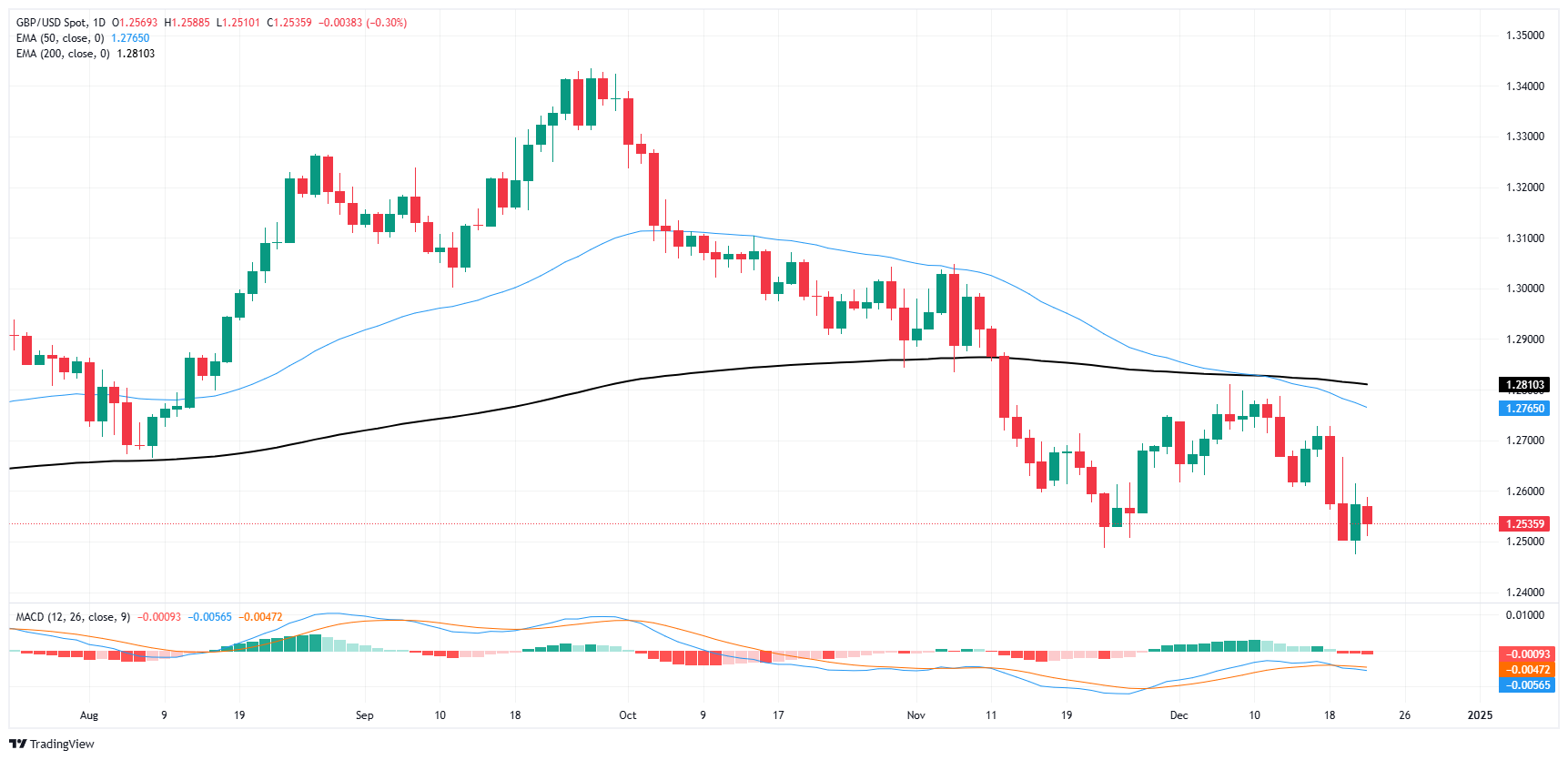- GBP/USD remained on the low side of 1.2550 on Monday.
- Money markets are tightening ahead of the midweek Christmas holiday.
- UK GDP figures slightly missed target to close the GBP data agenda early.
GBP/USD wavered near the 1.2550 level on Monday, starting the Christmas trading week with a drop of a third of a percentage point as market sentiment coils. Market volumes are expected to drain from global stock markets as investors generally hang up their hats for the Christmas holiday, with global markets closed on Wednesday.
UK Gross Domestic Product (GDP) missed downward expectations early Monday, with UK quarterly GDP declining to 0.0% in the third quarter compared to the expected 0.1%. The UK’s annualized GDP also missed forecasts, coming in at 0.9% year-on-year. Investors expected the annual figure to print in line with the previous period’s figure of 1.0%.
US durable goods orders also missed target on Monday, capping a decline in broader market sentiment. US durable goods orders fell in November, registering -1.1% compared to the expected -0.4%, and completely reversing the previous month’s revised figure of 0.8%. Most of the losses in durable goods orders came from automotive purchases, with core durable goods orders (excluding automobiles) recording -0.1%, still below the 0.3% forecast but better than the figure major.
The overall market reaction to the data has been limited to start the week, and will only get worse as market liquidity dries up. Significant data is all but finished for the week on both sides of the Atlantic, although US Initial Jobless Claims for the week ending December 20 will be released on Thursday. Whether or not there will be operators at their desks to watch the data cross the wires is another question entirely.
GBP/USD Price Forecast
GBP/USD continues to trade on the wrong side of the 200-day EMA near 1.2800, with price action lagging around the 1.2500 area. A bullish turn faded in late November, and Cable prices are destined to continue languishing.
The pair is still down almost 7% from September peaks near 1.3400. Any further attempts to build bullish momentum will need to break through the latest high, with technical resistance clustered near the 50-day EMA near 1.2765.
GBP/USD Daily Chart
British Pound FAQs
The British Pound (GBP) is the oldest currency in the world (AD 886) and the official currency of the United Kingdom. It is the fourth most traded foreign exchange (FX) unit in the world, accounting for 12% of all transactions, averaging $630 billion a day, according to 2022 data. Its key trading pairs are GBP/ USD, which represents 11% of FX, GBP/JPY (3%) and EUR/GBP (2%). The British Pound is issued by the Bank of England (BoE).
The most important factor influencing the value of the Pound Sterling is the monetary policy decided by the Bank of England. The Bank of England bases its decisions on whether it has achieved its main objective of “price stability” – a constant inflation rate of around 2%. Its main tool to achieve this is the adjustment of interest rates. When inflation is too high, the Bank of England will try to control it by raising interest rates, making it more expensive for people and businesses to access credit. This is generally positive for sterling, as higher interest rates make the UK a more attractive place for global investors to invest their money. When inflation falls too much it is a sign that economic growth is slowing. In this scenario, the Bank of England will consider lowering interest rates to make credit cheaper, so that companies will take on more debt to invest in projects that generate growth.
The data released measures the health of the economy and may affect the value of the pound. Indicators such as GDP, manufacturing and services PMIs and employment can influence the direction of the Pound.
Another important data that is published and affects the British Pound is the trade balance. This indicator measures the difference between what a country earns from its exports and what it spends on imports during a given period. If a country produces highly in-demand export products, its currency will benefit exclusively from the additional demand created by foreign buyers seeking to purchase those goods. Therefore, a positive net trade balance strengthens a currency and vice versa in the case of a negative balance.
Source: Fx Street
I am Joshua Winder, a senior-level journalist and editor at World Stock Market. I specialize in covering news related to the stock market and economic trends. With more than 8 years of experience in this field, I have become an expert in financial reporting.







